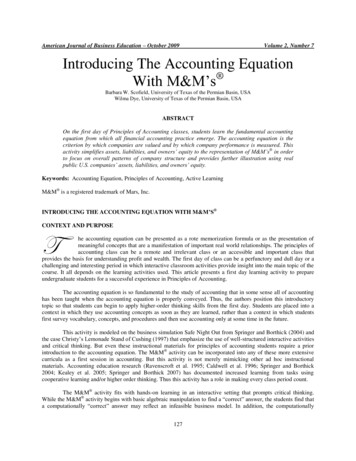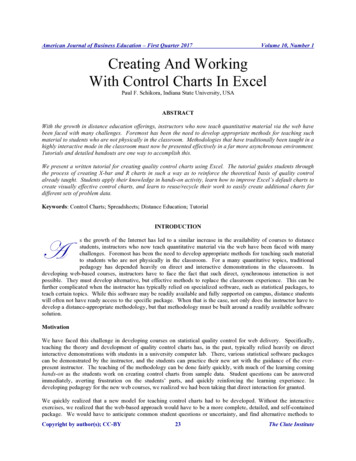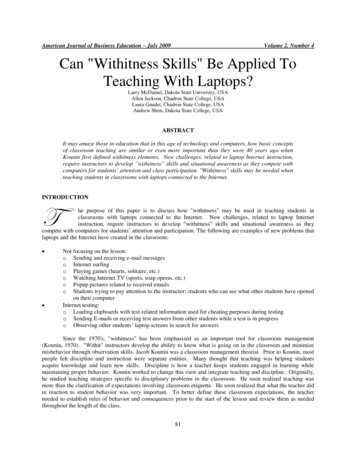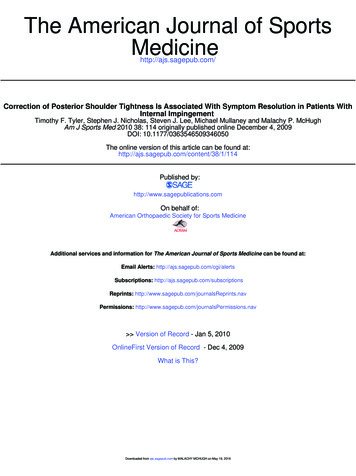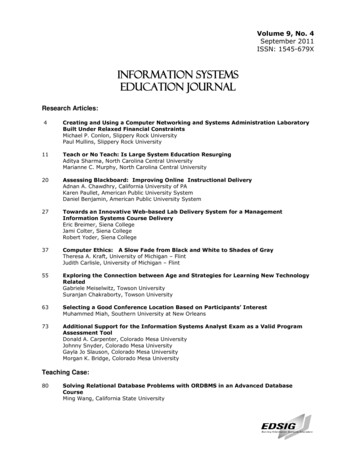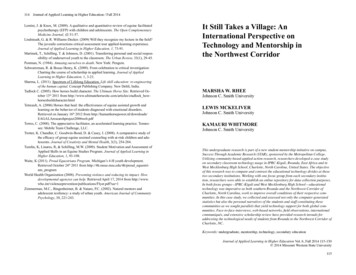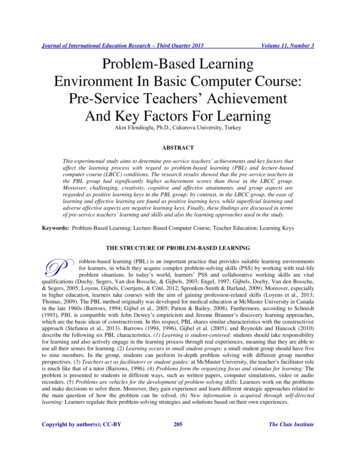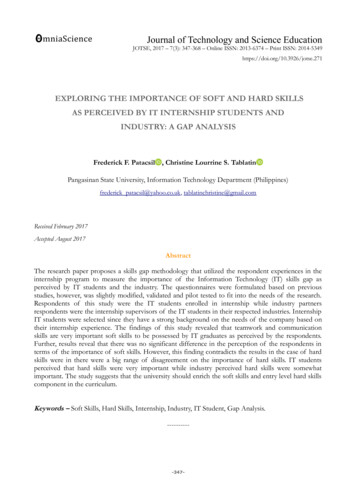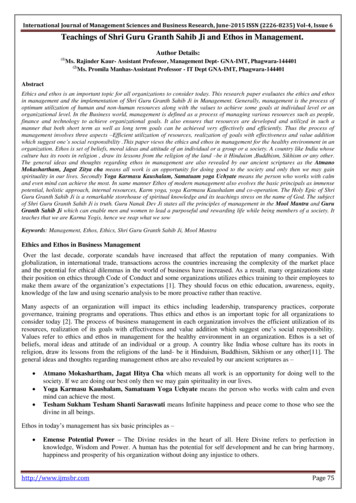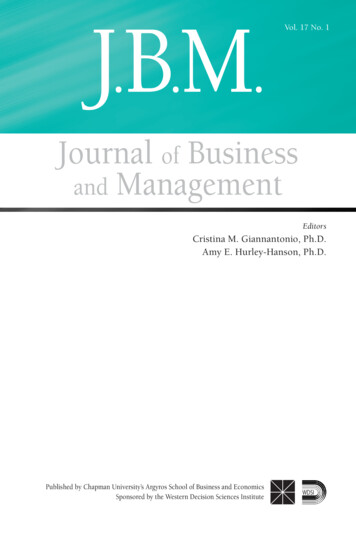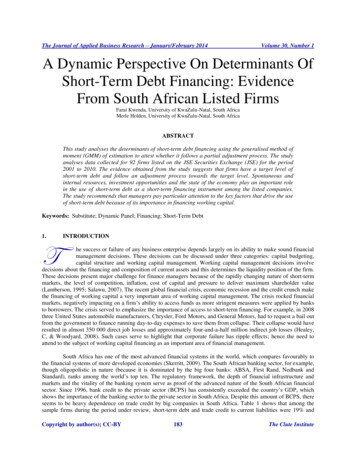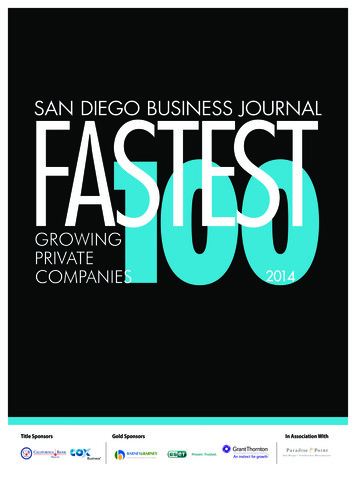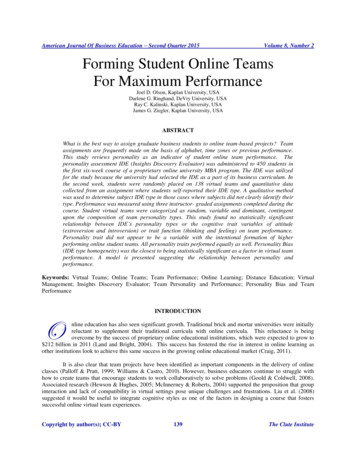
Transcription
American Journal Of Business Education – Second Quarter 2015Volume 8, Number 2Forming Student Online TeamsFor Maximum PerformanceJoel D. Olson, Kaplan University, USADarlene G. Ringhand, DeVry University, USARay C. Kalinski, Kaplan University, USAJames G. Ziegler, Kaplan University, USAABSTRACTWhat is the best way to assign graduate business students to online team-based projects? Teamassignments are frequently made on the basis of alphabet, time zones or previous performance.This study reviews personality as an indicator of student online team performance. Thepersonality assessment IDE (Insights Discovery Evaluator) was administered to 450 students inthe first six-week course of a proprietary online university MBA program. The IDE was utilizedfor the study because the university had selected the IDE as a part of its business curriculum. Inthe second week, students were randomly placed on 138 virtual teams and quantitative datacollected from an assignment where students self-reported their IDE type. A qualitative methodwas used to determine subject IDE type in those cases where subjects did not clearly identify theirtype. Performance was measured using three instructor- graded assignments completed during thecourse. Student virtual teams were categorized as random, variable and dominant, contingentupon the composition of team personality types. This study found no statistically significantrelationship between IDE’s personality types or the cognitive trait variables of attitude(extroversion and introversion) or trait function (thinking and feeling) on team performance.Personality trait did not appear to be a variable with the intentional formation of higherperforming online student teams. All personality traits performed equally as well. Personality Bias(IDE type homogeneity) was the closest to being statistically significant as a factor in virtual teamperformance. A model is presented suggesting the relationship between personality andperformance.Keywords: Virtual Teams; Online Teams; Team Performance; Online Learning; Distance Education; VirtualManagement; Insights Discovery Evaluator; Team Personality and Performance; Personality Bias and TeamPerformanceINTRODUCTIONOnline education has also seen significant growth. Traditional brick and mortar universities were initiallyreluctant to supplement their traditional curricula with online curricula. This reluctance is beingovercome by the success of proprietary online educational institutions, which were expected to grow to 212 billion in 2011 (Land and Bright, 2004). This success has fostered the rise in interest in online learning asother institutions look to achieve this same success in the growing online educational market (Craig, 2011).It is also clear that team projects have been identified as important components in the delivery of onlineclasses (Palloff & Pratt, 1999; Williams & Castro, 2010). However, business educators continue to struggle withhow to create teams that encourage students to work collaboratively to solve problems (Goold & Coldwell, 2008).Associated research (Hewson & Hughes, 2005; McInnerney & Roberts, 2004) supported the proposition that groupinteraction and lack of compatibility in virtual settings pose unique challenges and frustrations. Liu et al. (2008)suggested it would be useful to integrate cognitive styles as one of the factors in designing a course that fosterssuccessful online virtual team experiences.Copyright by author(s); CC-BY139The Clute Institute
American Journal Of Business Education – Second Quarter 2015Volume 8, Number 2There have been many studies reviewing the relationship of personality and team performance (Hewson &Hughes, 2005; Kline & O’Grady, 2009; McInnerney & Roberts, 2004). However, their results have beeninconsistent and inconclusive (Barry & Stewart, 1997; Kline, 1999; Taggar, 2000; van Viennen & De Drue, 2001;Yeatts & Hyten, 1998) resulting in a lack of consensus. Some researchers have indicated that personality is apotential predictor of team performance (Potter & Balthazard, 2002; Straus, 1996; Topi, et al., 2002; MacDonnell etal., 2009). Other research findings suggest a probable linkage between personality and team performance (Beise, etal., 2010; Chantal et al. (2010); Driskell et al., 1987; Faizuniah & Chan, 2014; Hackman, 1975; Moreland & Levine,1992; Rutti et al., 2012), but their results are inconclusive. Current research indicates that there is a lack of researchon successful team practices (Pinar et al., 2014).There has been considerable work comparing the performance of face-to-face and virtual teams. Someresearchers have found that virtual teams tend to be stronger than face-to-face teams related to group identity (Lea,Spears, & deGroot, 2001) and group norms (Spears et al., 1990). Other studies have indicated that virtual teams haveno performance advantage (Strauss and McGrath, 1994). However, while there would be value in comparing theimpact of personality on face-to-face and virtual teams, this study focused on the impact of personality on virtualteams.LITERATURE REVIEWPerformanceOver time, research has consistently indicated that groups fall short of reasonable performance baselines(Hill, 1982; Steiner, 1972). Steiner (1972) described this gap as process losses. Researchers have focused onidentifying exceptions to the process loss phenomenon by identifying tasks and contexts where groups exceed theirexpected baseline. This has been approached by determining a productivity baseline based on the performance ofthe most capable group member, looking for the group to exceed the performance of the most capable member.Some researchers have reported group performance exceeding the most capable member baseline (Laughlin et al.,1995, 1998, 2003). Similar studies have reported group performance exceeding the performance of any one groupmember, or combination of group members, resulting in a desired bonus effect (Laughlin et al., 2002; Michaelsen etal., 1989; Phadnis & Caplice, 2013; Sniezek & Henry, 1989; Tindale & Sheffey, 2002). However, these effects aretypically minimal (Booth, 2011; Kerr & Tindale, 2004) being related to the underestimation of a group’s potentialand the overestimation of the group’s performance (Tindale & Larson, 1992a, 1992b).There have been several approaches to understand group process loss. One clear source of group processloss is the failure to identify and use the resources of effective group members (Kerr & Tindale, 2004). A criticalgroup task then becomes the ability to identify member expertise. Work has been done to determine cues formember expertise. One cue to assess member expertise is loquacity which was defined by Littlepage (Littlepage etal., 1995; Littlepage & Mueller, 1995) as the ability of groups to use reason. Littlepage (Littlepage et al., 1995;Littlepage & Mueller, 1995) also used confidence, influence and dominance as cues to assess team memberpotential. Collective behaviors of groups are found to impact group success (Kim et al., 2011; Drouin et al., 2010).Work conditions have also been studied as a factor in improving recognition of effective group members. Someconditions that have been studied are explicit directions to find the most capable group member (Henry, 1995),regular performance feedback (Henry et al., 1996), previous experience working together (Littlepage et al., 1997;Goodman & Shah, 1992) and larger group size (Littlepage & Silbiger, 1992). Researchers have also looked atmemory as a feature related to how groups identify effective group members. Moreland (Moreland, 1999; Moreland& Argote, 2003) have defined this as a transactive memory, an awareness of member competency. Transactivememory can be built by group training where group members learn about member competencies (Liang et al., 1995).Impact Of Personality On PerformanceMacDonnell et al. (2009) reported that personality has been considered a potential indicator of teamperformance (Grinnell et al., 2012; Hewson & Hughes, 2005; Potter & Balthazard, 2002; Straus, 1996; Topi et al.,2002). Findings have not been consistent and even contradictory resulting in uncertainty regarding the relationshipof personality and performance (Barry & Stewart, 1997; Kline, 1999; Taggar, 2000; van Viennen & De Drue, 2001;Copyright by author(s); CC-BY140The Clute Institute
American Journal Of Business Education – Second Quarter 2015Volume 8, Number 2Yeatts & Hyten, 1998). Researchers have agreed that there is a likely connection between personality and teameffectiveness (Driskell et al., 1987; Hackman, 1975; Jenster, 2010; Moreland & Levine, 1992). O’Neil & Kline(2008) reported a relationship between personality and team performance (Barrick et al., 1998; Brandstatter &Farhofer, 1997; de Jong et al., 1999; Driskell et al., 1987). Personality traits have been associated with specific workbehavior as a means of predicting team outcomes (McGrath, 1998; Honts et al., 2012; Hough & Oswald, 2000).Previous studies have operationalized team personality composition in terms of two characteristics:elevation and variation (Barrick et al., 1998; Kichuk & Wiesner, 1998; Mohammed & Angell, 2003; Neuman &Wright, 1999; Peeters et al., 2006; Van Vianen & De Dreu, 2001). In those correlational studies, elevation ispredominately defined as the averaged or summed individual scores per trait and variation as the team’s variance orstandard deviation score per trait (Peeters et al., 2006). They also point out that trait elevation is calculated by theaveraged or summed individual scores for a trait or by the proportion of high scoring individuals on a trait. Traitvariability is represented by a team’s variance or standard deviation score for a certain trait.Peeters et al. (2006) conducted a meta-analysis on the relationship between personality and teamperformance based on the Big Five Inventory categories of Extraversion, Agreeableness, Conscientiousness,Emotional Stability and Openness to Experience. Their findings indicated that with both elevation and variation,Extraversion was not a factor with team performance. Agreeableness did appear to be a factor indicating that higherelevations led to higher performance. However, this effect was much more pronounced with professional teamsthan student teams. Higher average levels of Conscientiousness contributed to better performance. Elevations withEmotional Stability and Openness to Experience were also found to not correlate with increased team performance.Varvel et al. (2004) reported no relationship between team average MBTI data and team effectiveness,which suggested that while personality may play a role in team performance; it is not predictive. The study didindicate that individuals who knew and understood their personality type (MBTI) helped them to improve theircommunication, interdependence and trust. Individuals’ knowledge of each other’s personality strengths andpreferences facilitated effective communication, which enabled the team to capitalize on individual strengths(Cannon-Bowers et al., 1995). However, the utilization of personality factors to predict virtual team performancecontinues to be unclear (Topi et al., 2002).Gardner and Martino (1996) reviewed the utilization of MBTI in management research questioning therelationship of personality types to profession. Caution was suggested when linking MBTI and work behavior basedupon their extensive review of empirical literature reviewing correlation between MBTI and work behavior. Theysuggested the empirical data did not support the utilization of MBTI in this way. Other researchers have alsoquestioned the utility of the MBTI related to career counseling (Bjork & Druckman, 1991; Boyle, 1995). Althoughthe MBTI is quite popular, it lacks the psychometric properties for empirically proven predictions (Pittinger, 2005)Insights Discovery EvaluatorThe IDE is based on the psychological type’s theory of Dr. Carl Jung and Jolande Jacobi. Jung suggestedthat personality is the result of interaction of the two attitude traits (extroversion and introversion) and two functiontraits (thinking and feeling). Attitude traits describe an individual’s orientation to the world and function traitsdescribe an individual’s mental processes (Jacques, et al., 2009). While attitude can be understood to be related tomood and be dynamic, Jung's use of attitude refers to a trait. Jung's use of the term function also refers to a trait.IDE presents this balance in terms of four colors, each a specific behavioral pattern as summarized in Figure 1(Insights, 2014). A sample IDE Report can be reviewed at Insights-Discovery.pdfThe IDE is listed on the British Psychological Society Psychological Testing Centre page under TestRegistration and Test Reviews and-test-reviews/test-reviews.cfm?page summary&Test ID 99).The IDE was presented at the 11th European Congress of pMode AbstractView&pAbstractId 11003) and has wide face validityas evidenced by its utilization in 25 languages. The IDE was used by 24,224 individuals between November, 2003and July, 2004 in the UK alone (Benton et al, 2006)Copyright by author(s); CC-BY141The Clute Institute
American Journal Of Business Education – Second Quarter 2015Volume 8, Number 2The University of Westminster’s Business Psychology Centre completed a validity and reliability study ofthe IDE. Benton, et al., (2008) found that “of the 24,224 evaluators (completed between 31/11/2003 and 31/7/2004in the UK) for each of the four colors in the evaluator, the average ‘inter-item’ correlation coefficient is significantlyabove 0.3, providing strong evidence of the case for reliability” (p. 22).They also found that the Cronbach-Alphacoefficient was approaching 1 and that there was construct validity using factor analysis, concurrent and predictivecriterion validity.The construct validity has been demonstrated through factor analysis and there is good predictive validitydata by profession. These results all compare favorably with other Jungian-based instruments that are held in highregard by psychometricians and which also meet the standards set out by both the American PsychologicalAssociation and the British Psychological Society. “In summary, there is strong evidence to support the four-colormeasures calculated from the Insights Discovery model being both reliable and valid” (Benton et al., 2006, p 50).Figure 1: IDE Four Type WheelImpact Of Cognitive Processes On Team PerformanceThe IDE Jungian trait categories of attitude and function describe cognitive processes. Liu et al. (2008)pointed out that there had been minimal work reviewing the relationship of cognitive processes and virtual teamperformance. Sternberg proposed a correlation between work environment and cognitive thinking style (1997).Individuals perform better when placed in a work environment that matches their cognitive thinking style(Mukherjee et al., 2012). Hayes and Allison (1998) pointed out that local people may prefer work environments thathave access to data and the time to process that data while global people may not need this base knowledge to becreative. Other researchers have reported that cognitive processes were not a factor in virtual team performance(Lui, 2012; Kim et.al., 2011).Copyright by author(s); CC-BY142The Clute Institute
American Journal Of Business Education – Second Quarter 2015Volume 8, Number 2Many studies regarding the role of cognitive style in team work performance have focused on traditionalworkplaces. Less research has been conducted on the relationship between cognitive process and virtual teamperformance. Workman et al. (2003) found that in virtual work environments, people with external styles who prefergroup interactions had a higher commitment to virtual team work than those without such styles. CunninghamAtkins and his associates (2004) found that in a computer mediated group discussion online, the teams with a greaterdiversity of cognitive styles outperformed less diversified teams. There is also empirical evidence to support thelinkage of cognitive style and work environment for improved team performance. Individuals whose cognitive stylesalign with the competencies needed have increased satisfaction (Cunningham-Atkins et al., 2004; Hayes & Allinson,1998).Impact Of Bias On Team PerformanceConvertino (2008) stated that individual bias was a factor in team performance. Team bias is based on thepersistence of individual bias found in team members. Homogeneous groups were more biased than heterogeneousgroups. Increasing group diversity decreases bias and increases team performance (Schult-Hart et.al., 2000). Tolcottet al. (1989) demonstrated the tendency of expert intelligence analysts to prefer information given at the start of thescenario disregarding subsequent information that changed the overall weight of information. Another source of biasis the product of group processes (Kerr & Tindale, 2004). Team members with a minority view are less likely to beheard and their information considered, even if the information is critical. Gigone and Hastie (1996) described thisas the common knowledge effect. These biases erode the potential value of bringing together a diversity ofknowledge and skills. Team performance is likely to be improved with increased diversity resulting in more sharedknowledge and perspective (van Knippenberg & Schippers, 2007). However, too much diversity can require largeinitial investments in building common ground, which may diminish team performance (Convertino, 2008).Team ModelThe input-process-output model (IPO) is a widely accepted model for understanding team effectiveness(Driskell et al., 1987). The IPO model suggests that input (individual, environmental and group level factors) andprocess (e.g., communication, conflict) affect team output (Barrick et al., 1998). This paper uses the IPO model as aframe for understanding the impact of personality on team performance (see Figure 2).RESEARCH METHODHypothesesH1A:H2A:H3A:H4A:Teams with a majority of members with the Cognitive Trait Attitude of Extroversion (IDE Red and Yellowtypes) have a greater probability to perform better than teams with a majority of members with theCognitive Trait Attitude of Introversion (IDE Blue and Green types).Teams with a majority of members with the Cognitive Trait Function of Thinking (Blue and Red types)have a greater probability to perform better than teams with a majority of members having the CognitiveTrait Function of Feeling (IDE Green and Yellow types).Teams with a majority of members having a Red IDE type have a greater probability to perform better thanteams with a majority of members having the Yellow IDE type, Green IDE type or Blue IDE type Blue.Teams with lower bias (teams with all four IDE types) have a greater probability to perform better thanteams with higher bias (teams with one dominant IDE type).ApproachThe study utilized a general mixed methods research methodology. Pairs of researchers collectedqualitative data reviewing a team assignment transcript where students reported their IDE type. The qualitative datawere as not entered until there was full consensus with each pair regarding assignment of IDE type to each student.Those teams where one or more team members did not indicate their IDE type, or the researchers could notdetermine their IDE type, were excluded from the study. Each researcher received IDE training. One researcher wasan IDE certified instructor who served as final arbitrator. Quantitative data were collected in the form of numericalgrades (performance) on team assignments and reviewed using descriptive statistics, t-tests and ANOVA testing.Copyright by author(s); CC-BY143The Clute Institute
American Journal Of Business Education – Second Quarter 2015Volume 8, Number 2Cognitive Style – Trait Attitude :Extroversion/Introversio
Joel D. Olson, Kaplan University, USA Darlene G. Ringhand, DeVry University, USA Ray C. Kalinski, Kaplan University, USA James G. Ziegler, Kaplan University, USA ABSTRACT What is the best way to assign gradu
